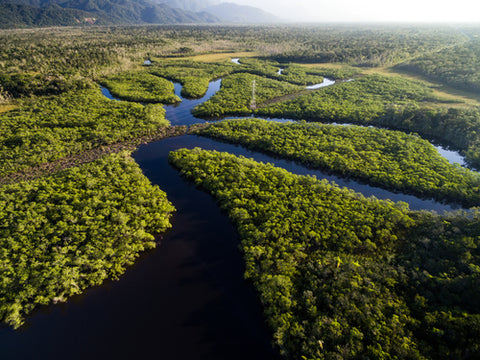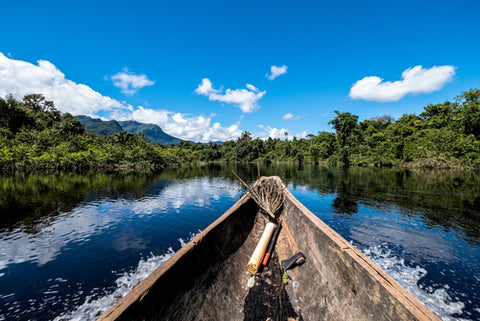Home to 1.4 billion acres of tropical forests, more than 4,000 miles of wild rivers and over 5,500 animal species, the Amazon rainforest is a marvel like no other. In fact, this awe-inspiring jungle is the world’s largest rainforest, covering around 40% of South America. It’s a compelling place with some serious sublimity – that we already knew. But what have you not heard about the Amazon jungle? We go deep to discover some of the more little-known Amazon rainforest facts.

8 Amazon rainforest facts you haven’t heard
1) More species than anywhere else
While you might find it impressive that the Amazon rainforest has thousands of species of mammals, fish, birds and reptiles combined, these numbers have nothing on the colossal quantity of invertebrates. There are estimated to be an enormous 100,000 invertebrate species, most of which are insects, dwelling in the Amazon jungle. But among the thousands of termites, cockroaches, butterflies and beetles, it’s ants that take up the most space. It’s been suggested that more than 30% of the Amazon rainforest’s animal biomass is made up of ants – and many of them are deadly.
2) Most of our favourite fruit is found in the Amazon
Around 80% of the fruits we eat are found in the Amazon rainforest. From avocados to grapefruit, this jam-packed jungle is also bursting with spices like ginger and turmeric. Even our everyday coffee beans might have originated in the Amazon jungle. In total, we consume about 200 of these fruits – however, there’s actually more than 3,000 to choose from in the entire rainforest.
3) And our nuts and seeds are from there, too
Most of us will know of the native Brazil nut, plus the popular cashew which can be found in the Amazon rainforest. But there’s one nut which hasn’t quite swamped our social media yet with its superfood status (although we bet it will). The Kahai nut, from the tree of the same name, is a highly sustainable food that has no waste. From fertiliser to fuel, every part of the Kahai nut can be used. It can even be cold-pressed into an ultra-nourishing miracle oil, as found in our Forming Cream. With 50% more vitamin E than Argan oil and 3 times the amount of Retinol than Rosehip oil, Kahai nut oil also boasts a high content of vitamin F, which is why we use this miracle oil throughout our product range. This ingredient from the Amazon rainforest is one to watch.
4) It probably won’t be a spider bite which kills you
If you did feel like going for a stroll through the Amazon jungle, the chances are you wouldn’t last for very long. While the warm climate and appetising fruits might seem tempting, you probably couldn’t survive. Considering the snakes, spiders, piranhas, jaguars, plus the poisonous dart frog which can kill 10 adults with a single dose – the Amazon’s not looking like your next holiday destination. However, even if you did manage to outdo these deadly creatures, you may not be able to hide from one of the biggest risks of the Amazon rainforest: the mosquito. What might seem like an insignificant mosquito bite could end up giving you a fatal dose of malaria or dengue fever.

5) Thinking of swimming the Amazon river? You’ve been beaten to it
Back in 2007, long-distance swimmer Martin Strel tackled the mighty Amazon river. In just 66 days, Slovenia-born Strel swam a record-breaking 5,268 km, battling through perilous waters for up to 10 hours a day. Strel’s team even poured blood into the river to keep piranhas away from the endurance athlete.
6) Uncontacted tribes call the Amazon rainforest home
It’s thought around 500 indigenous tribes inhabit the Amazon jungle, with between 50-100 of them never having any contact at all with the outside world. And these tribes make it clear they want things to stay that way. Some have shot arrows at passing planes, or live a nomadic lifestyle hidden in the forest and can’t be found so easily.
7) It takes 10 minutes for rain to reach the ground
The Amazon jungle’s tropical climate is known for its alternating wet and dry seasons, though you’ll find rainfall in both. But even the heaviest of showers struggle to break through the rainforest’s dense canopy. The thickness of the tree’s leaves and branches mean it takes rain up to 10 minutes for rain to reach the ground. Plus, this overwhelming canopy completely shadows the Amazon’s floor, making it entirely black in some areas.
8) Over 20% of the Earth’s oxygen is produced by the Amazon rainforest
Often called the ‘lungs of the planet,’ the Amazon rainforest a life-sustaining essential. One of the most crucial contributors to the Earth’s climate, the Amazon jungle produces 20-40% of our oxygen while also absorbing carbon dioxide. And while deforestation has declined in the past decade, tree growth is deteriorating too – damaging our entire biosphere.
Here’s what we know about the Amazon: it’s dense, it’s dangerous, but it’s a definitive treasure on our planet. The Amazon, the asset – one which every member of mankind should be in awe of.
Check out the rest of the Daimon Barber Journal for even more insight into #TheModernMan lifestyle. We are champions of innovation and sustainability. Don’t forget to keep up to date with our social side too – we’re on Facebook, Twitter and Instagram. Welcome to NOW.





